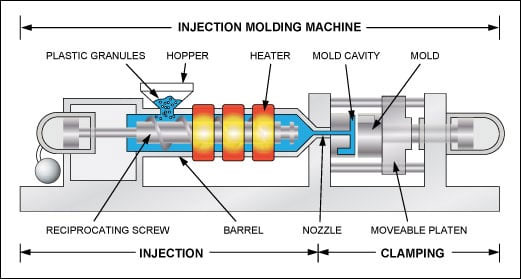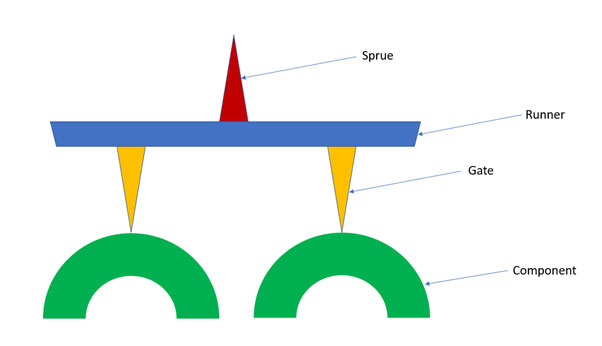The process of plastic injection moulding takes place in an injection moulding machine which in the main consists of the clamping unit, injection unit, and the mould tool.
At the clamping stage, the two halves of the mould are closed before injecting the molten plastic. The tool is clamped together after the molten material has dwelled in the tool cavity cavities. The clamping unit is responsible for:
- Applying sufficient clamping force to resist the injection force, keeping the mould closed during injection step until the dwelling step.
- Ejecting the moulded part after the dwelling step.
- Opening and closing the mould tool plates between the mould cycles.
- Holding the mould plates in alignment.

The clamping unit consists of:
- The platen holds the mould halves when it is attached to the injection moulding equipment.
- The fixed platen holds the front mould half and houses the nozzle of the injection unit, which is directly aligned with the front mould half. The moving platen moves the rear half of the mould by sliding on the tie bar during the opening and closing of the mould.
- The tie bar supports the moving platen during translation and aligns the mould plates. The size of the tie bar limits the size of the mould tool that can be loaded into an injection moulding machine.
- The clamping system is responsible for translating the movable platen towards the stationary plate of which there are three types:
- Toggle clamps are suitable for moulding machines with low tonnage requirements.
- Hydraulic clamps use pressure to translate the movable platen and to create the force required to hold the mould halves during the injection step.
- Hydromechanical clamps can provide a larger clamping tonnage of more than 1,000 tons. The operation of hydromechanical clamps is a combination of the toggle and hydraulic clamping systems.
- The ejection system
Injection
At the injection stage, the plastic granules are heated and melted then delivered to the mould via the injection unit. The injection unit is responsible for:
- Delivering molten plastic to fill the mould cavities, called a shot. The shot is dependent on the volume of the part.
- Applying heat to melt and homogenize the plastic granules before injecting them into the mould.
- Applying sufficient injection pressure and speed to force the molten plastic to fill the mould cavities.
The injection mould machine has various parts:
- The hopper, which is a large container where the raw plastic granules are introduced to the reciprocating screw inside the barrel.
- The heaters provide thermal energy to melt the plastic pellets to their molten state.
- The reciprocating screw pushes the plastic through the length of the barrel by both rotating and sliding axially. The hydraulic cylinder supplies the injection pressure. As the plastic works its way along the length of the barrel it becomes more viscous due to combined heat, pressure, and friction. The molten plastic is accumulated in front of the screw and its backflow is prevented by a non-return valve.
- A nozzle introduces the molten plastic to the mould cavities. It is located in the stationary platen and is directly aligned with the front half of the mould.
Dwelling and Cooling
Once the molten plastic is in the mould, it is allowed to dwell inside the cavities. The injection pressure is replaced by the holding pressure where the molten plastic solidifies.
Cooling starts once the molten plastic comes in contact with the surface of the cavities. Cooling is facilitated by the cooling system inside the mould which removes the heat. After cooling the part for sufficient time, the two halves of the mould are separated, and the part is ejected.
Ejection
At the ejection stage, the cooled part is separated from the mould. The ejection system, which is in the clamping unit, enables the removal of the moulded part from the cavities.
Trimming
The last step in the production of moulded parts is trimming, where any excess plastic is removed.
During injection of the molten plastic, the mould channels (sprue, runners, and gates) are filled. After cooling, the excess plastic materials adhere to the part which needs to be removed.

The Mould Tool
- The mould tool in the main consists of two plates, which are attached to the clamping plates. The front mould half is next to the injection unit. The rear half of the mould is attached to a movable plate which allows opening and closing of the mould.
- The mould cavity is the shaped section which gives the parts their final shape. When the molten plastic flows into the cavity, taking up its shape and volume.
- A mould tool can have multiple cavities depending on volume requirements. Injection cycles may be a little longer, however overall, the volume manufactured allows for speedier manufacturing and lower costs.
- The parting line is a line found in the closed half of the mould tool. A parting line may be a straight line or a curve in more complex tooling designs. Air is easiest to vent in the parting line as molten plastic tends to move to this area. Air vents eliminate trapped gases inside the mould tool.
- The locating ring aligns the nozzle to the front mould tool plate.
- The sprue is the first channel of the molten plastic from the nozzle of the mould tool and has several runners connected.
- The runner distributes the molten plastic to the mould cavity.
- The gate directs the flow of the molten plastic into the cavities by narrowing its flow path. It is located at the end of each runner. A cavity may contain one or more gates.
Injection Moulding Parameters
- Clamping pressure is also referred to as the tonnage. It is the pressure required to hold the mould halves during the injection stage.
- Injection pressure is the pressure applied by the screw or plunger to force the molten plastic through the cavities until it is 95% filled.
- Holding pressure is applied after the cavity is 95% filled until the solidification of the gates. It is about half of the injection pressure. Holding pressure is necessary to improve the compactness of the moulded part and to control shrinkage and cooling of the part.
- Injection speed is the rate at which the screw rotates to transfer the molten plastic to the mould cavities.

